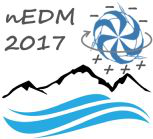Conveners
WeMo2
- Beatrice Franke (TRIUMF)
Georg Bison
(Paul Scherrer Institut)
18/10/2017, 10:50
Magnetic field sensors (atomic co-magnetometry, AQUIDS, fluxgate)
Oral
Experiments searching for the electric dipole moment (EDM) of the neutron require a stable and homogeneous magnetic field. Statistical and systematic uncertainties in such experiments depend on magnetic field gradients and fluctuations of those gradients and the field itself. In order to monitor the different aspects of the magnetic field we developed a variety of special magnetometer systems...
Dr
Tomohiro Hayamizu (for the TRIUMF Japanese-Canadian UCN Collaboration)
(The University of British Columbia)
18/10/2017, 11:15
Magnetic field sensors (atomic co-magnetometry, AQUIDS, fluxgate)
Oral
In support of the neutron electric dipole moment (EDM) experiment at TRIUMF, we are developing a $^{129}$Xe/$^{199}$Hg dual-comagnetometer that can monitor the magnetic field drift and reduce the uncertainties arising from geometric phase effects caused by inhomogeneous fields.
Using UV light sources, we will excite transitions in $^{129}$Xe and $^{199}$Hg suitable for detection of their spin...
Steven Clayton
(Los Alamos National Laboratory)
18/10/2017, 11:40
Magnetic field sensors (atomic co-magnetometry, AQUIDS, fluxgate)
Oral
In the SNS nEDM experiment, liquid helium at around 0.4 Kelvin will fill and surround the measurement cells. In addition to its roles in superthermal production of ultracold neutrons and scintillator, the liquid helium has excellent dielectric strength, and the planned electric field in the cells is ~75 kV/cm. This field requires a voltage applied to the central electrode of ~650 kV. Instead...
Dr
Ekaterina Korobkina
(NCSU)
18/10/2017, 12:05
Systematic effects
Oral
nEDM @SNS experiment is designed to be able to measure neutron EDM down to $10^{−28}$ range due to special technique for suppressing systematic effect arising from magnetic field gradients in presence of electric field. This technique requires cryogenic environment at about 0.5K and use of polarized $^3He$ in the same cell as trapped neutrons. We also plan to utilize simultaneous spin dressing...

